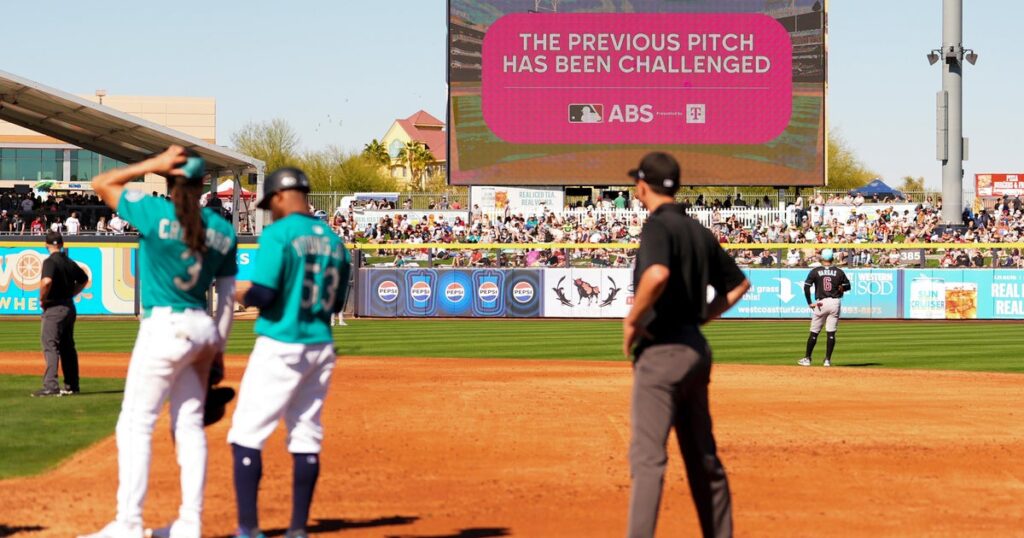Robot umpires are getting called up to the big leagues next season.
Major League Baseball’s 11-man competition committee on Tuesday approved use of the Automated Ball/Strike System in the major leagues in 2026.
Human plate umpires will still call balls and strikes, but teams can challenge two calls per game and get additional appeals in extra innings. Challenges must be made by a pitcher, catcher or batter — signaled by tapping their helmet or cap — and a team retains its challenge if successful. Reviews will be shown as digital graphics on outfield videoboards.
Adding the robot umps is likely to cut down on ejections. MLB said 61.5% of ejections among players, managers and coaches last year were related to balls and strikes, as were 60.3% this season through Sunday. The figures include ejections for derogatory comments, throwing equipment while protesting calls and inappropriate conduct.
Big league umpires call roughly 94% of pitches correctly, according to UmpScorecards.
ABS, which utilizes Hawk-Eye cameras, has been tested in the minor leagues since 2019. The independent Atlantic League trialed the system at its 2019 All-Star Game and MLB installed the technology for that year’s Arizona Fall League of top prospects. The ABS was tried at eight of nine ballparks of the Low-A Southeast League in 2021, then moved up to Triple-A in 2022.
In 2019, Fred DeJesus became the first umpire in a regular-season game to use ABS. He remembers the first pitch he tested – it was a strike – and how he was hesitant about the new technology at first.
“Initially, it was like, no way, we’re not doing this. I spent way too much money trying to learn the craft of calling balls and strikes,” he told CBS News in 2021.
At Triple-A at the start of the 2023 season, half the games used the robots for ball/strike calls and half had a human making decisions subject to appeals by teams to the ABS.
MLB switched Triple-A to an all-challenge system on June 26, 2024, then used the challenge system this year at 13 spring training ballparks hosting 19 teams for a total of 288 exhibition games. Teams won 52.2% of their ball/strike challenges (617 of 1,182) challenges.
At Triple-A this season, the average challenges per game increased to 4.2 from 3.9 through Sunday and the success rate dropped to 49.5% from 50.6%. Defenses were successful in 53.7% of challenges this year and offenses in 45%.
ABS was used in this year’s All-Star Game as well and has generally received positive reviews, CBS Sports reported. Four of five challenges of plate umpire Dan Iassogna’s calls were successful in July.
Teams in Triple-A do not get additional challenges in extra innings. However, the proposal approved by the MLB on Tuesday included a provision granting teams one additional challenge each inning if they don’t have challenges remaining.
MLB has experimented with different shapes and interpretations of the strike zone with ABS, including versions that were three-dimensional. Currently, it calls strikes solely based on where the ball crosses the midpoint of the plate, 8.5 inches from the front and the back. The top of the strike zone is 53.5% of batter height and the bottom 27%.
This will be MLB’s first major rule change since sweeping adjustments in 2024. Those included a pitch clock, restrictions on defensive shifts, pitcher disengagements such as pickoff attempts and larger bases.
The challenge system introduces ABS without eliminating pitch framing, a subtle art where catchers use their body and glove to try making borderline pitches look like strikes. Framing has become a critical skill for big league catchers. While there was concern that full-blown ABS would make some strong defensive catchers obsolete, not everyone considers the skill a good thing.
“The idea that people get paid for cheating, for stealing strikes, for moving a pitch that’s not a strike into the zone to fool the official and make it a strike is beyond my comprehension,” former manager Bobby Valentine said.
Texas manager Bruce Bochy, a big league catcher from 1978-87, maintained old-school umpires such as Bruce Froemming and Billy Williams never would have accepted pitch framing. He said they would have told him: “‘If you do that again, you’ll never get a strike.’ I’m cutting out some words.”
Management officials on the competition committee include Seattle chairman John Stanton, St. Louis CEO Bill DeWitt Jr., San Francisco chairman Greg Johnson, Colorado CEO Dick Monfort, Toronto CEO Mark Shapiro and Boston chairman Tom Werner.
Players include Arizona’s Corbin Burnes and Zac Gallen, Detroit’s Casey Mize, Seattle’s Cal Raleigh and the New York Yankees’ Austin Slater, with the Chicago Cubs’ Ian Happ at Detroit’s Casey Mize as alternates. The union representatives make their decisions based on input from players on the 30 teams.
Bill Miller is the umpire representative.
The competition committee can unilaterally implement on-field rule changes with 45 days’ notice to the MLB Players Association, according to CBS Sports.
https://www.cbsnews.com/news/mlb-robot-umpires-2026-season-challenge-system/


